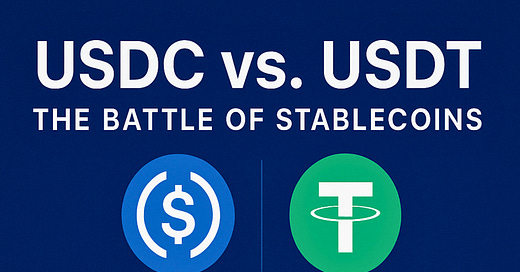In the ever-evolving world of blockchain and Web3, stablecoins have emerged as a critical foundational layer — providing the stability of fiat currency with the programmability of crypto. At the center of this stablecoin revolution are two dominant players: USDC (USD Coin) and USDT (Tether).
At first glance, both coins serve the same purpose: offering a 1:1 peg to the U.S. dollar. But dig deeper, and you’ll uncover differences in transparency, regulatory approach, market adoption, and developer focus.
This article breaks down the USDC vs USDT landscape — helping developers, businesses, and investors choose the right tool for their goals in a multi-chain, decentralized world.
1. What Are USDC and USDT?
USDC (USD Coin)
Launched by: Centre Consortium (co-founded by Circle and Coinbase)
Blockchain support: Ethereum, Solana, Avalanche, Polygon, Base, and more
Highlights: Transparent, U.S.-regulated, widely used in institutional and enterprise-grade solutions
USDT (Tether)
Issued by: Tether Ltd.
Blockchain support: Ethereum, Tron, Solana, Algorand, BNB Chain, and many more
Highlights: Market liquidity leader, preferred in Asia and emerging economies, especially for retail and trading use
Though they appear to offer the same utility, the organizations and philosophies behind them differ significantly.
2. Transparency and Reserve Management
The credibility of a stablecoin lies in its backing. Users need to know that every digital dollar is backed by real-world assets. Here's how USDC and USDT handle this:
USDC: Regulated and Transparent
Backed 100% by cash and short-term U.S. Treasuries
Monthly attestation reports published by major U.S. audit firms
Circle, the issuer, is a registered money transmitter in the U.S., operating under FinCEN oversight
Maintains a consistent public push for regulatory clarity and engagement with global regulators
USDT: Dominant but Disputed
Historically backed by a mix of reserves (including commercial paper, secured loans, corporate bonds, etc.)
Has faced criticism for limited transparency and delayed audits
In recent years, Tether has made progress by publishing reserve breakdowns and reducing riskier asset exposure
Still under scrutiny in jurisdictions like the U.S. and parts of Europe
3. Adoption, Liquidity & Market Dynamics
Stablecoins aren't just tech—they're economic infrastructure. And adoption depends on user trust, exchange partnerships, and regional demand.
As of early 2025, USDT’s market cap exceeds $105 billion, with unmatched dominance in daily trading volume.
Powers major centralized exchanges (Binance, OKX, Bitfinex) and is heavily used on Tron, due to low transaction costs.
Favored in regions with limited banking infrastructure (e.g., Asia, Latin America, Africa) where it serves as a hedge against inflation or currency instability.
USDC leads in compliance and enterprise integration
With a market cap of ~$28 billion, USDC has carved out a niche in regulated fintech, Web3 startups, and enterprise finance.
Popular with neobanks, payment providers, and platforms offering cross-border settlements.
Finds usage in tokenized assets, on-chain payroll, and DeFi protocols aligned with U.S. and European compliance frameworks.
4. Developer Perspective: Which Should You Build With?
When it comes to integrating a stablecoin into your platform,
USDC Offers:
Robust APIs and SDKs from Circle, including for cross-border transfers, yield products, and stablecoin settlements
Out-of-the-box compliance, making it ideal for financial services, payroll platforms, and tokenized asset apps
Native support and partnerships with Layer 2 networks like Base, Optimism, and Arbitrum — improving cost efficiency and speed
USDT Offers:
Lower gas fees on Tron and BNB Chain — ideal for retail use and high-volume DeFi transactions
Flexible minting/burning operations (though criticized for lack of control)
More accessible on major trading platforms, and supported by many wallets, even in low-bandwidth or mobile-first markets
Choosing Between Them:
If you're building for regulated DeFi, real-world asset tokenization, or fintech infrastructure → choose USDC.
If you're focused on on-chain arbitrage, international P2P payments, or maximizing gas efficiency → USDT may be better suited.
5. Risks, Regulation & Real-World Impact
USDC:
Strong alignment with future U.S. stablecoin regulations
Transparent reserve reporting and full-dollar backing builds confidence
Well-positioned for CBDC integration or future government partnerships
USDT:
Faces regulatory uncertainty in the U.S. and Europe
Past controversies around reserve assets still impact institutional perception
Tether has denied banking relationships with certain jurisdictions — a red flag for some risk-averse partners
6. USDC and USDT consolidate comparison
As someone working at the intersection of crypto, fintech, and global payments, I see stablecoins as the first mainstream success of blockchain.
They’re programmable, borderless, and (when properly audited) trustworthy. Their real-world utility — from cross-border salaries to yield-bearing digital cash — is only just beginning.
We might debate USDC vs USDT today — but the real winner is the rise of internet-native money.




